Larix decidua from Alps is used almost exclusively as raw material and, since October 2001, only wood with EN 45011 PEFC certification has been processed. This kind of certification assures that forests, where wood came from, are protected with a sustainable management, which allows them to maintain biodiversity, productivity, regeneration capacity, vitality and ecological-economic-social functions. As an added value, Richter decided not to treat with impregnating agents the wood used.
Demetra is the Italian retailer and playground assembler of Richter Spielgeräte GmbH, which has internally created a sector that deals with environmental and sustainability issues (DENVA). Therefore, a new goal arose: calculate the environmental impact associated to one of the factory-built structure. So,
in agreement with Demetra and in collaboration with the University of Milan (Politecnico), a Life Cycle Assessment study was conducted and the playground equipment chosen was the Climbing Structure 06 (Fig. 1) installed in the Aldo Moro Park in Agrate Brianza -MB-, from now on called just CS06.
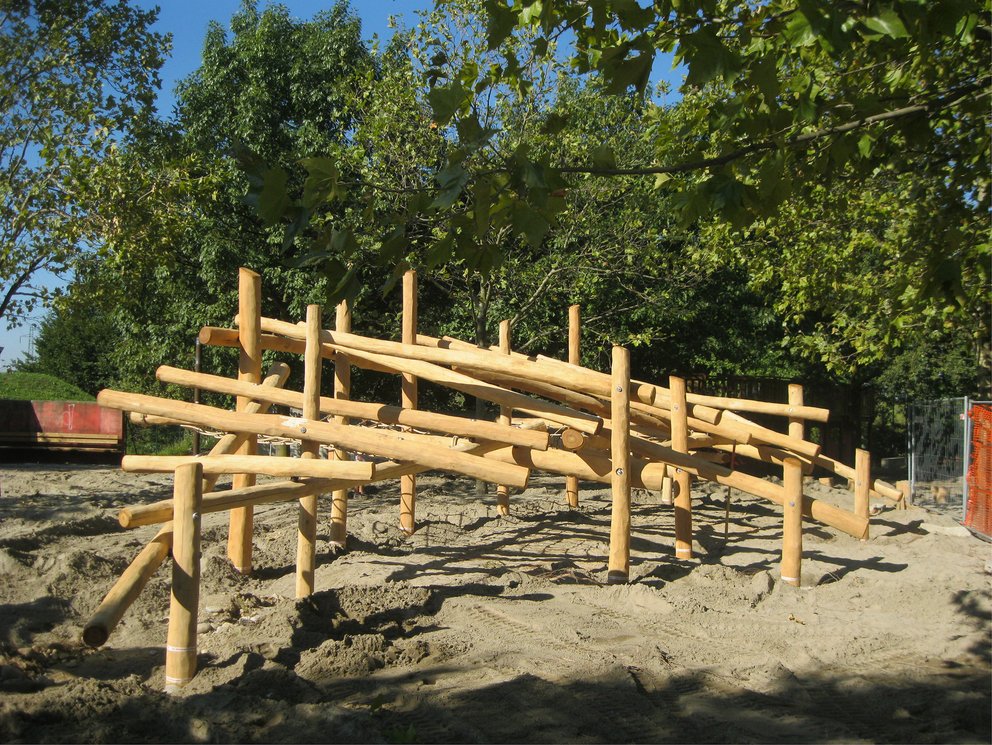
Figure 1 - Climbing Structure 6 (CS06)
A Life Cycle Assessment is a quantitative methodology which permit to estimate environmental impacts associated with all the stages of a product's life: from raw material extraction, through materials processing, manufacture, distribution and use, arriving finally to disposal or recycling process. The main interest of conducting an LCA is to highlight phases responsible of the major impacts, so that strategies can be subsequently identified in order to minimize the effects on environment and human health of the entire process. The LCA study has been conducted according to requirements exposed in the two international ISO standards, ISO 14040:2006 and ISO 14044:2006, which define the correct and shared methodology to be followed. In addition, another European standard was used, UNI EN 15804, which propose a trace to follow in LCA management on construction products, a category in which CS06 can be included.The analysis of the Climbing Structure CS06 aimed to examine all the main effects on environment and health, in order to cover all the phases of the life cycle: from the production in Frasdorf Richter factory to the CS06 placement in an Italian construction site (Fig. 2), considering potential scenarios for dismantling.
According to the above-mentioned Standards, the study has a Cradle to Grave perspective, so processes considered can be divided in 3 main phases, which are within the System Boundaries considered (Fig. 3).
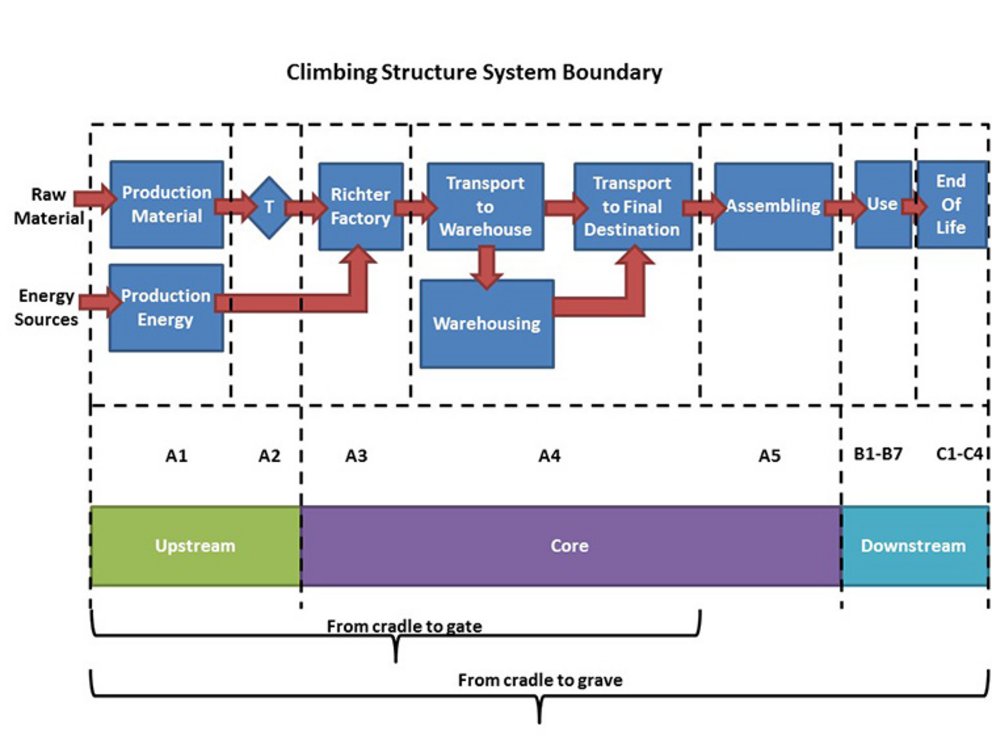
Figure 3 - System Boundary

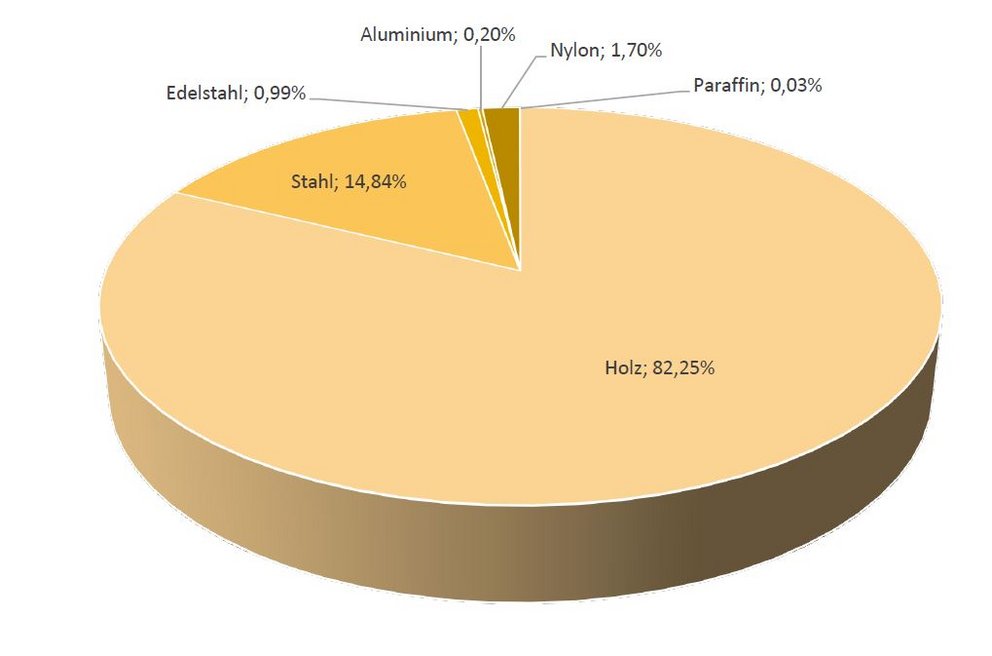
For convenience, we’ll divide all the stages into 4 different macro-areas, as described below.
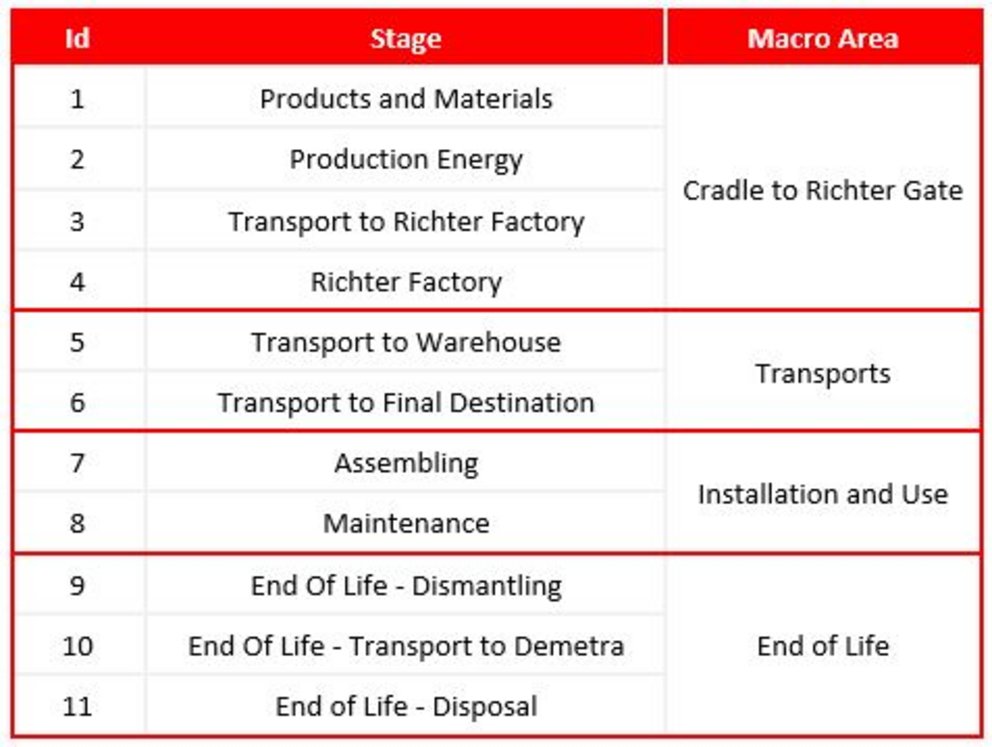
The environmental impact assessment was possible thank to the use of a specific software, called Simapro and its database Ecoinvent. Different kind of calculation methods (IPCC 2013 100a, ILCD, Recipe), with relative indicators, were used. Methods and the most significative impact indicators are described in glossary and their amount are shown in each method explanation.
Global Warming Potential (GWP 100), calculated with IPCC method is 6.644,16 kg CO2 eq, divided as follows (Graphic 1): 40,3 % of the total amount is due to 7.Assembling most of all because of concrete and gravel production and placement; 33,4% derived from 6.Transports to final destination, particularly of gravel used for playground base; 17,5% of impacts are given from 1.Products and Materials, especially for Steel Feet production, followed by Flexible Net and Larch Wood. CO2 eq computed with other method falls within 0,5% of difference, so we can assume the reported value as correct.
Relevant impact categories obtained from the ILCD method are described below. Freshwater Ecotoxicity, Acidification, Photochemical Ozone Formation trends ares the same of the one shown for the GWP: impacts derived from 7. Assembling, 6. Transport to Final Destination and 1. Products and Materials together exceed 90% of total amount; the difference is that the most impactful materials are here steel and aluminum. Another significant category is Land Use impact: in this, 7. Assembling stage is the most responsible of total impacts with a percentage of 92,2% alone (Graphic 2). This is reasonable because actually a portion of land was occupied for the playground construction.
Considering Recipe method, it’s interesting underline that the 3 critical stages are again the ones carrying biggest impacts also in Human toxicity, but with a different order: 6. Transport to Final Destination represent 46,8%, 1.Products and Materials the 31,9% and 7. Assembling the 16% (Graphic 3). Other data to be highlighted are that the production of wood inside the first stage involve a certain amount of Agricultural land occupation and that there’s a significant Water Depletion in metal production process.
Here follow final considerations about results obtained:
- Transports, in particular to final destination, are the main responsible for the overall impact in almost all categories. Exceptions are Land use impact, because the use of soil is ascribed where the structure is installed, and the consumption of water and raw materials, for which the greatest impacts come from the production of materials.
- Production phase of the CS06 structure contribute, in the majority of categories, at about 20% of the overall impact.
- For any impact category and in all the methods considered, the end of life phases (macro area 4) contribute negligibly to the impacts of the system.
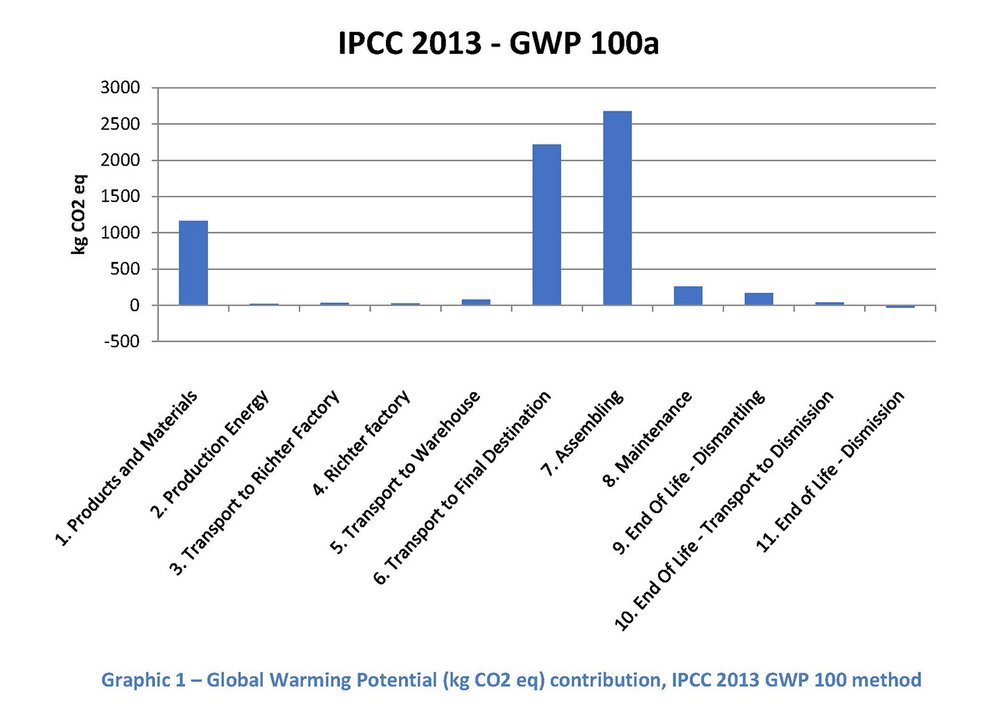
Graphic 1 - Global Warming Potential (kg CO2 eq) contribution, IPCC 2013 GWP 100 method
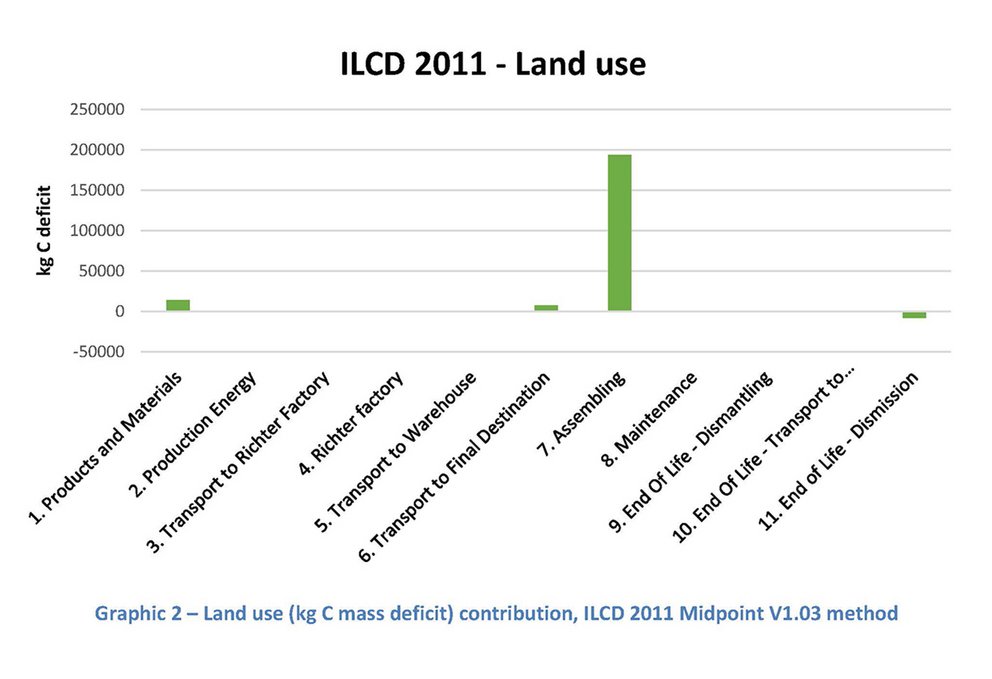
Graphic 2 – Land use (kg C mass deficit) contribution, ILCD 2011 Midpoint V1.03 method
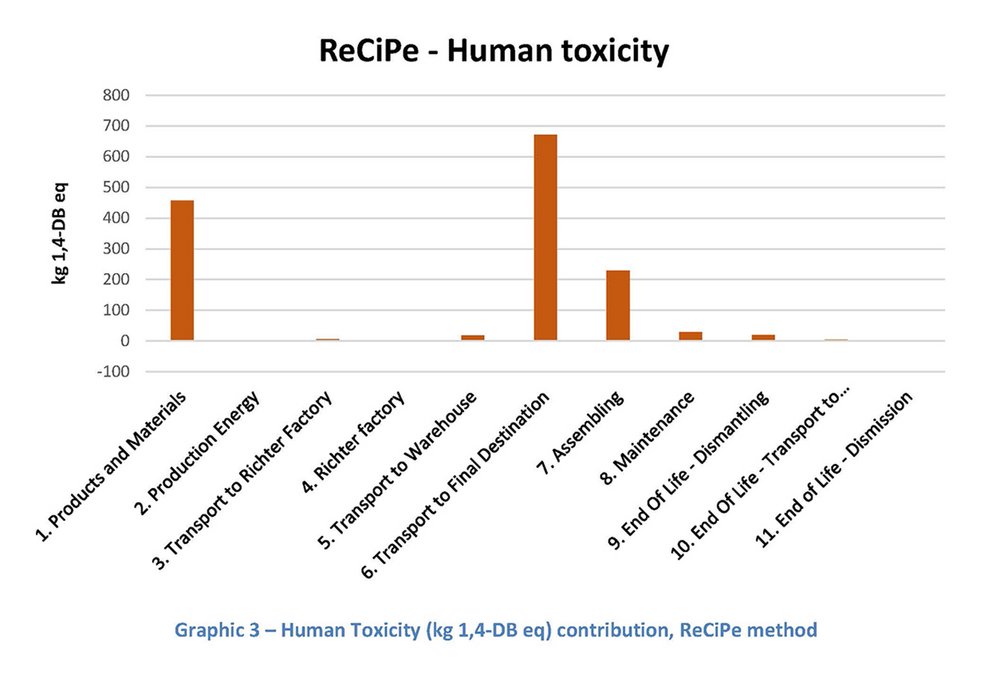
Graphic 3 – Human Toxicity (kg 1,4-DB eq) contribution, ReCiPe method


